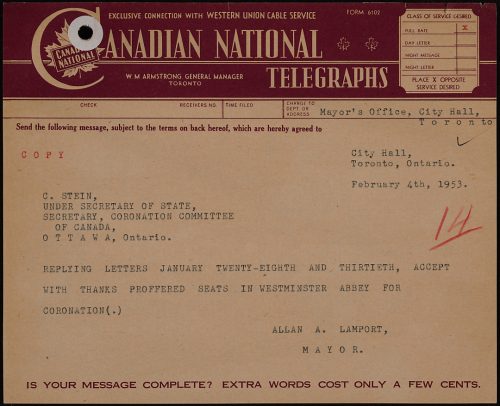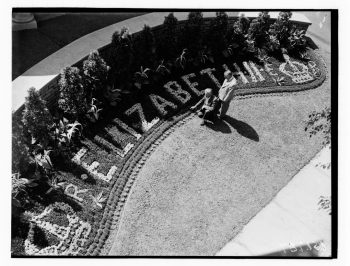

The City of Toronto congratulates His Majesty King Charles III upon the occasion of his coronation. See what other levels of government are doing to celebrate this event:
Few can remember the coronation of the King’s late mother, Queen Elizabeth II. That event took place almost 70 years ago in June 1953. For most, the coronation of King Charles III will be the first they witness. The mysterious and storied ritual of the late Queen’s coronation was watched with enthusiasm by Torontonians in the early 1950s, while today, within the context of reconciliation with indigenous peoples and reflections about colonial legacies, there is a general feeling of ambivalence towards the May 6th ceremony. This exhibit provides a glimpse into how a very different Toronto celebrated the momentous occasion of Elizabeth’s crowning.
Princess Elizabeth became Queen Elizabeth II at the moment of her father’s death on February 6, 1952; however, a traditional coronation ceremony was a formal and elaborate event that took many months to plan. In Toronto, a Coronation Celebrations Committee was set up early in 1953, and took the lead in planning.
Even before the Committee began its work, plans were formulated in late 1952 for Toronto Mayor Allan Lamport to represent the city at the coronation. Lamport was a veteran of the Second World War and keen royal admirer. The Mayor joined Canada’s official delegation, along with other officials, including Prime Minister Louis St. Laurent, several provincial premiers and Squamish Nation Chief Joe Mathias.

Approved by City Council for several weeks’ absence, Lamport boarded the ocean liner RMS Queen Elizabeth in New York for the five-day crossing to Southampton. He was accompanied by his wife Edythe and two daughters at a cost of $500 per person each way (about $5,600 each way in 2023 dollars). They stayed at the Hyde Park Hotel in London, attended a pre-coronation Royal garden party at Buckingham Palace, where they, along with many others, were presented to the Queen.
While Mayor Lamport was representing Toronto at Westminster Abbey in London, the city government and other institutions and businesses marked the coronation through numerous celebrations and official ceremonies. In the days leading up to June 2, 1953, City Hall was decorated with flags and a portrait of the Queen, following the design suggestions of the T. Eaton Company, a department store that was owned by a family of passionate monarchists.

Eaton’s two downtown department stores (on Yonge and Queen streets and Yonge and College streets), and its archrival Simpson’s, were also elaborately decked out the weekend before the coronation. Drapery and colourful flags sparked significant traffic jams as curious Torontonians sought a glimpse of the pageantry.

Coronation Day was proclaimed a holiday, and Toronto’s official recognition of it began with a special late-morning meeting of City Council, offering the Queen the City’s allegiance and prayers. Immediately afterwards, there was a public ceremony outside City Hall, which was attended by many prominent Torontonians. Controller Leslie H. Saunders read out the official Address of Loyalty and Devotion. Hymns and prayers followed, most of them read by Anglican Diocesan Bishop Ray Beverley. Other Christian and Jewish faith leaders also attended, including Rabbi Abraham Feinberg of Holy Blossom Temple.

Canadian military representatives also marched in parade at the ceremony. After the City Hall event, some 100,000 spectators lined University Avenue as Toronto Garrison military personnel from all service branches marched to the University of Toronto campus for a drumhead service. After more prayers, speeches and a public radio broadcast of the Queen’s coronation message, there was a 21-gun salute and an RCAF fly past.
The City’s official advertisement listed many other celebrations that took place throughout the day, particularly in its parks. Newspaper accounts indicate there were even more events than were advertised. That afternoon, three thousand new Canadians pledged their loyalty in a ceremony at Exhibition Place. The Canadian National Exhibition grounds featured a floral tribute and would prominently display coronation decorations during its 1953 fair. As well, Black community leader Donald Moore led a small dedication service at Victoria Memorial Square, pledging loyalty and commemorating Black and Indigenous soldiers who had fought for the British during the War of 1812. Finally, members of Toronto’s Chinese community set off a tremendous display of fireworks.

Coronation celebrations were not limited to the downtown core. The suburban municipalities all had their own events, some of them rivalling the pomp and ceremony of downtown.
East York witnessed a crowd of 30,000, lined up along Cosburn Avenue for the largest parade in that municipality’s history, with bands, Girl Guides and Boy Scouts, police officers, firefighters and school children marching to its commemoration service. In Leaside’s Talbot Park, another 20,000 watched fireworks.

Etobicoke’s lakeshore communities organized parades and tree plantings, particularly in Alderwood Memorial park in New Toronto, where the staff of local industries, Continental Can and Anaconda Brass, participated enthusiastically.
In York, 12,000 people gathered for an outdoor pit barbecue, songs, and fireworks. There were also fly pasts in North York, and parades in Scarborough. As the day of Queen Elizabeth’s coronation turned into evening, the people of Toronto continued to celebrate by attending dances, parties, and other social events.

Finally, as coronation day celebrations drew to a close, people who had television sets suddenly became very popular, because a recording of the coronation service at Westminster Abbey was available to watch on the CBC. The BBC tapes had been flown by RAF jets across the Atlantic in a non-stop crossing – a milestone moment in the early age of television.
Later, more people were able to view the service when local movie theatres re-broadcast the footage in glorious technicolor, and for free admission.
All in all, Queen Elizabeth II’s coronation day on June 2, 1953 was a day to be remembered fondly by many in Toronto, Ontario, and across Canada.